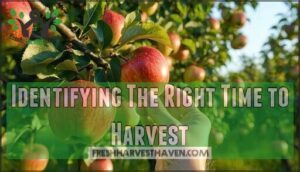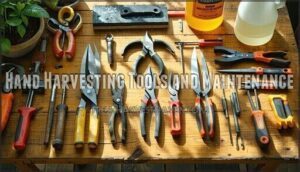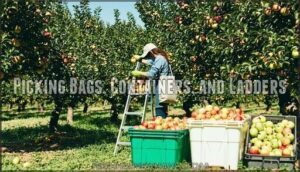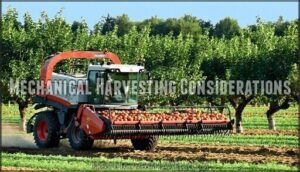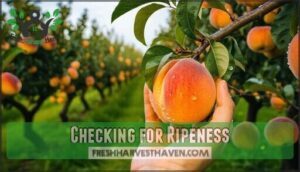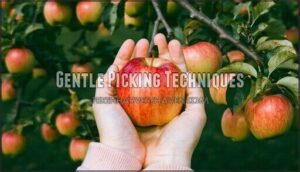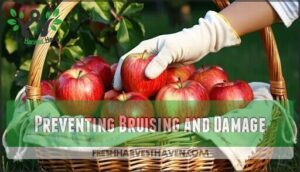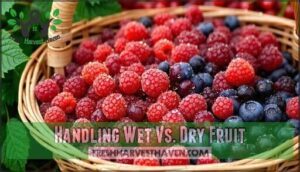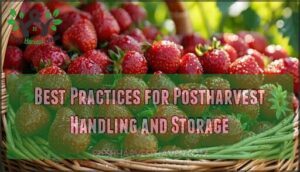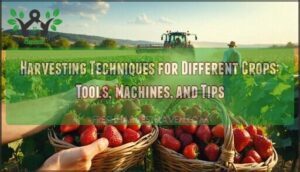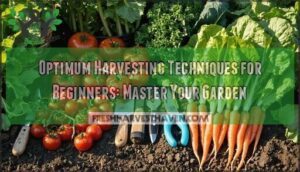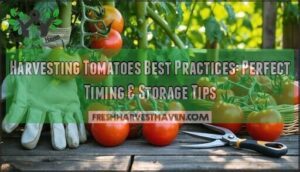This site is supported by our readers. We may earn a commission, at no cost to you, if you purchase through links.
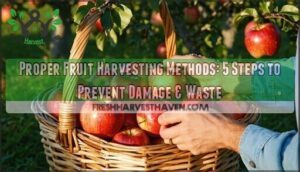 You can’t achieve proper fruit harvesting methods to prevent damage without focusing on timing, technique, and tool selection. Start by checking for visual ripeness indicators like color changes and slight softening, then use clean, sharp tools to make gentle cuts rather than pulling fruit from branches. Handle each piece carefully, placing it—don’t drop it—into padded containers to avoid bruising.
You can’t achieve proper fruit harvesting methods to prevent damage without focusing on timing, technique, and tool selection. Start by checking for visual ripeness indicators like color changes and slight softening, then use clean, sharp tools to make gentle cuts rather than pulling fruit from branches. Handle each piece carefully, placing it—don’t drop it—into padded containers to avoid bruising.
Harvest during cooler morning hours when fruit is firm, and always wash your hands and sanitize tools between different plants to prevent contamination. The difference between amateur picking and professional harvesting often comes down to mastering these subtle techniques that protect both quality and shelf life.
Table Of Contents
- Key Takeaways
- Why Safe Fruit Harvesting is Essential
- Identifying The Right Time to Harvest
- Choosing and Using Proper Harvest Tools
- Step-by-Step Safe Fruit Harvesting Methods
- Best Practices for Postharvest Handling and Storage
- Frequently Asked Questions (FAQs)
- How can harvesting improve the quality of fruits?
- How do you handle fruits & vegetables during harvesting?
- How do you maintain fruit quality after harvesting?
- How to keep fruits fresh after harvest?
- What are some effective harvesting practices?
- What are the good harvesting practices?
- What are the 4 methods of harvesting PPT?
- What are the preventive methods for post-harvest losses?
- What are the three most common harvesting methods?
- What should you do to avoid damages during harvesting?
- Conclusion
Key Takeaways
- Time your harvest perfectly – Check for visual ripeness indicators like color changes and slight softening, then harvest during cool morning hours when fruit is firm and dry to prevent moisture-related damage and contamination.
- Use gentle handling techniques – Apply palm pressure instead of fingertips when picking, make clean cuts with sharp tools rather than pulling fruit, and place—don’t drop—each piece into padded containers to avoid bruising.
- Maintain proper tool hygiene – Wash your hands and sanitize all harvesting tools between different plants to prevent cross-contamination and foodborne illnesses that can affect the entire supply chain.
- Implement correct postharvest care – Cool fruit immediately after harvest, maintain proper temperature and humidity during storage, and conduct daily inspections to catch early signs of decay before it spreads to healthy produce.
Why Safe Fruit Harvesting is Essential
When you harvest fruit incorrectly, you’re basically throwing money away while risking the health of everyone who’ll eat your produce.
Poor harvesting techniques turn premium fruit into worthless waste and dangerous health hazards.
Proper harvesting techniques protect your fruit’s quality, extend shelf life, and prevent contamination that could make consumers seriously ill.
Impacts on Produce Quality and Shelf Life
Your harvesting methods directly determine how long your fruit stays fresh and maintains its nutritional value. Poor handling techniques at the ripening stage create bruising that accelerates decay, while gentle handling and proper storage conditions preserve produce quality.
Smart harvesting methods and postharvest care protect your investment, ensuring maximum shelf life and reducing costly waste from damaged fruit.
Preventing Foodborne Illnesses and Waste
Poor hygiene practices during harvesting create contamination sources that lead to foodborne illnesses and significant waste reduction challenges. You’ll prevent contamination by implementing proper sanitation protocols, including clean tools and hands before touching fruit. Safe harvesting techniques combined with food safety protocols protect consumers while maintaining storage conditions that extend shelf life, reducing economic losses from spoiled produce.
Effects on Supply Chain and Consumer Health
Your harvesting decisions ripple through the entire food system, affecting everyone from distributors to families at dinner tables. When you implement proper fruit harvesting and postharvest management techniques, you’re preventing illness outbreaks that can devastate communities and protecting the economic impact on farmers and retailers.
Every harvest choice ripples through families, communities, and supply chains worldwide.
Quality fresh produce with extended shelf life maintains nutritional value, while food safety protocols during produce handling techniques guarantee consumers receive the healthy fruits they deserve. To guarantee safety, remember that clean tools matter during the harvesting process.
Identifying The Right Time to Harvest
Knowing when to harvest each fruit type requires careful observation of specific maturity indicators that vary substantially between varieties. You’ll need to monitor visual cues like color changes and physical signs such as firmness, along with conducting gentle tests like the "twist method" to determine peak ripeness before quality deteriorates.
Visual and Physical Maturity Indicators
You’ll know your fruit’s ready when color development shifts from green to its mature hue, and size variation becomes consistent across the plant. Check for aroma changes that signal ripeness, while skin texture transforms from firm to slightly yielding.
Examine stem condition for easy separation, as proper fruit development timing guarantees superior produce quality. Through effective fruit harvesting methods, equipment, and techniques.
Fruit Types and Ripening Patterns
Different fruits follow distinct ripening patterns that affect when you should harvest them. Climacteric fruits like apples and bananas continue ripening after picking through ethylene production, while non-climacteric fruits such as citrus and berries must reach full ripeness on the plant.
Understanding these varietal differences in fruit development guarantees you harvest at the right time using proper fruit harvesting methods and techniques.
Daily Monitoring for Optimal Ripeness
Ripeness stage monitoring requires consistent daily checks since many fruits ripen rapidly within days. Environmental factors like temperature and humidity influence harvest timing, making monitoring frequency critical for maintaining fresh produce quality.
You’ll need to assess fruit variation across your crop, as individual pieces reach ideal ripeness at different rates. Effective harvest management means checking produce quality indicators each morning to harvest at the right time.
Choosing and Using Proper Harvest Tools
The right tools can make the difference between flawless fruit and bruised produce that won’t sell. You’ll need sharp, clean hand tools, proper containers, and safe access equipment to harvest efficiently while maintaining fruit quality.
Hand Harvesting Tools and Maintenance
When selecting the right hand harvesting tools, prioritize quality over convenience since your equipment directly impacts fruit integrity. Sharp, clean tools prevent bruising and contamination while ergonomic designs reduce worker fatigue during extended picking sessions. Consider browsing a selection of specialized picking equipment for superior results.
- Tool Sanitation: Clean harvesting tools with sanitizing solution between different varieties or fields to prevent cross-contamination
- Sharpening Techniques: Maintain razor-sharp pruning shears and harvest knives using whetstones or professional services for clean cuts
- Tool Storage: Store hand harvesting tools in dry, organized spaces with proper tool storage systems to prevent rust and damage
Picking Bags, Containers, and Ladders
Your choice of picking bags, containers, and ladders directly impacts harvest quality and worker safety. Select fruit pickers bags with ergonomic design and proper bag material to prevent shoulder strain. Verify that container ventilation prevents moisture buildup while capacity considerations match your strength. Consider specialized picking equipment for efficiency.
Prioritize ladder safety with stable positioning and three-point contact for fruit harvesting safety.
Mechanical Harvesting Considerations
Mechanical harvesting equipment requires precise machine calibration to achieve ideal crop suitability and damage reduction. Automation benefits include increased efficiency, but cost analysis reveals higher sorting expenses post-harvest.
Proper machinery operation safety training guarantees harvesting techniques minimize fruit injury while maintaining farm equipment safety standards throughout the process.
Ergonomic tools can help reduce physical strain during harvesting.
Step-by-Step Safe Fruit Harvesting Methods
You’ll achieve the best results by following a systematic approach that protects each fruit from the moment you touch it. The key is combining proper ripeness assessment with gentle handling techniques that preserve both quality and shelf life.
Checking for Ripeness
Before you pick that first fruit, timing determines everything. Visual indicators and physical tests reveal ideal ripeness better than guesswork ever could. Master these four checkpoints for premium produce quality:
- Color changes – Watch for uniform hue shifts specific to each variety
- Texture testing – Apply gentle pressure near the stem end
- Aroma detection – Sweet fragrance signals peak maturity stages
- Stem separation – Easy release indicates readiness for hand harvesting
To further enhance your assessment, consider fruit’s weight density as an indicator of juiciness.
Gentle Picking Techniques
Once you’ve confirmed ripeness, use your palm instead of fingertips for hand picking. This gentle handling technique distributes pressure evenly, reducing bruising on delicate fruit surfaces. Cradle each piece in your palm while using minimal finger pressure to detach from the stem.
Hand harvesting requires soft containers that won’t compress your harvest, and remember—avoiding drops is key to maintaining quality throughout your fruit harvesting process.
Preventing Bruising and Damage
Beyond gentle picking techniques, protecting your harvest requires strategic damage prevention. Bruising occurs when fruit experiences pressure or impact during collection.
- Gentle Handling: Use your palm rather than fingertips when lifting fruit to distribute pressure evenly across the surface.
- Proper Containers: Select padded picking bags and shallow containers that prevent fruit from crushing under its own weight.
- Reduce Drops: Keep container heights minimal and avoid tossing fruit, even short distances damage cell walls.
- Worker Training: Teach harvesters to recognize quality indicators and understand how their actions affect produce quality and shelf life.
Hand Harvesting Techniques combined with Proper Tools maintain high Produce Quality compared to Mechanical Harvesting methods that increase bruising risk.
Handling Wet Vs. Dry Fruit
When fruit gets wet from rain or morning dew, surface moisture effects increase decay risks substantially. You’ll want ideal timing for harvesting best practices—pick when completely dry to prevent post-harvest risks.
Handling differences matter: wet fruit needs immediate drying and gentle handling to maintain produce quality. Post-harvest care requires sanitized containers and controlled humidity for wet fruit.
Cooling berries quickly helps to slow respiration and maintain their quality, so consider forced air cooling.
Best Practices for Postharvest Handling and Storage
Your fruit’s journey doesn’t end when it leaves the tree—proper postharvest handling determines whether you’ll enjoy weeks of fresh produce or watch it spoil within days.
You’ll need to master washing, grading, packing, and storage techniques that maintain quality while preventing the costly mistakes that turn perfect harvests into compost.
Washing, Grading, and Packing
After harvesting, you’ll need to clean and sort your fruit carefully to maintain produce quality. Washing techniques remove field debris and contaminants, while proper grading standards separate fruit by size and ripeness. Use appropriate packing materials that cushion delicate skin, and implement quality control checks throughout packing lines to prevent handling damage and guarantee consistent fruit packaging standards. Some even utilize zero energy cool chambers for storage.
Temperature and Humidity Control
Your storage environment makes or breaks fruit quality after postharvest handling. Maintain humidity levels between 85-95% to prevent shriveling while avoiding excess moisture that encourages decay. Use rapid cooling methods like forced air to remove field heat quickly, then monitor temperature continuously with digital sensors.
Ethylene producers should be stored separately to prevent premature spoilage. Controlled atmosphere storage further extends shelf life by regulating gas composition around fresh produce.
Regular Inspection and Safe Transport
Check your stored fruit daily for early signs of decay, soft spots, or damage that could spread to healthy produce.
When transporting fresh produce, maintain proper vehicle sanitation by cleaning transport containers between loads and securing your load to prevent shifting during route planning that could cause bruising through inadequate postharvest handling practices. **Selecting the right containers for safe transport is also essential.
Frequently Asked Questions (FAQs)
How can harvesting improve the quality of fruits?
Like striking gold, you’ll boost fruit quality by timing harvests perfectly at peak ripeness, handling gently to prevent bruising, and picking during cool morning hours when moisture’s low.
How do you handle fruits & vegetables during harvesting?
Handle fruits and vegetables gently using your palm rather than fingertips to prevent bruising. Harvest during cool morning hours when produce is dry, and use clean, sharp tools to minimize damage and contamination risks.
How do you maintain fruit quality after harvesting?
Picture fruits as living treasures that need your gentle care after harvest. You’ll maintain quality by cooling them quickly, handling with soft touches, and storing at proper temperatures and humidity levels.
How to keep fruits fresh after harvest?
Cool fruits immediately after picking in shaded areas, then store them at proper temperatures with adequate ventilation.
Handle gently during transport, avoid washing until ready to use, and maintain ideal humidity levels to prevent moisture loss and extend freshness.
What are some effective harvesting practices?
Harvest fruits at peak ripeness, during cool morning hours when they’re dry. Use gentle handling techniques, palm pressure instead of fingertips, and sharp, clean tools to prevent bruising and contamination.
What are the good harvesting practices?
You’ll enhance fruit quality by harvesting at peak ripeness, working during cool morning hours when produce is dry.
Use gentle handling techniques, sharp clean tools, and proper containers to prevent bruising and contamination.
What are the 4 methods of harvesting PPT?
Hand harvesting involves picking fruits manually, usually preferred for delicate produce. Machine harvesting uses mechanical equipment for efficiency.
Strip harvesting removes all fruits simultaneously, while selective harvesting picks only ripe fruits across multiple visits.
What are the preventive methods for post-harvest losses?
An ounce of prevention is worth a pound of cure" – you’ll prevent post-harvest losses by maintaining proper temperature control, using gentle handling techniques, implementing quick cooling systems, and ensuring clean storage environments with adequate ventilation throughout the supply chain.
What are the three most common harvesting methods?
You’ll encounter three primary harvesting methods: hand picking, mechanical harvesting, and selective harvesting.
Hand picking offers precise control for delicate fruits, while mechanical systems handle larger volumes efficiently, and selective harvesting targets only ripe produce.
What should you do to avoid damages during harvesting?
Harvest fruits when they’re fully ripe, using gentle palm pressure rather than fingertips.
Work during cool morning hours when produce is dry. Handle carefully to prevent bruising, and use sharp, clean tools for clean cuts.
Conclusion
Ironically, many people think harvesting fruit requires about as much skill as opening a bag of chips—grab and go. However, mastering proper fruit harvesting methods to prevent damage actually demands precision, timing, and careful technique.
You’ll protect your harvest’s quality by following the five essential steps outlined above: identifying ideal ripeness, selecting appropriate tools, using gentle picking techniques, preventing bruising, and implementing correct postharvest handling.
These methods substantially reduce waste, extend shelf life, and guarantee maximum nutritional value reaches consumers safely.
- https://eversprout.com/blogs/blog/fruit-picking-101-tips-and-techniques-for-harvesting-your-homegrown-produce
- https://www.fast-growing-trees.com/blogs/plant-care-guides/fruit-trees-101-harvesting
- https://content.ces.ncsu.edu/introduction-to-the-postharvest-engineering-for-fresh-fruits-and-vegetables/8-harvesting-and-handling-fresh-produce
- https://felixinstruments.com/blog/how-to-improve-post-harvest-quality-in-fresh-produce/
- https://www.growingproduce.com/fruits/tips-to-reduce-bruising-when-harvesting/

